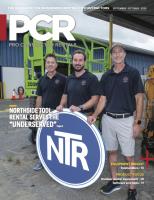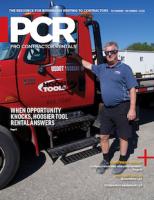Business analysis: Top three issues in the equipment industry
Equipment companies used to compete mostly on product and price, but that was before customers could get whatever they needed with just a click of a button.
By Andreas Hellström
With reduced differentiation and diminishing sales margins, equipment companies are shifting the focus beyond product and price to what problems they can solve for their customers.
One of the biggest challenges equipment OEMs, dealers, rental and service organizations face today is how to increase customer service levels. Finding new and better ways to serve customer needs are at the core of the key issues impacting the equipment industry today.
Here is how the equipment industry is addressing the need to compete on customer service.
1. Shifting customer behavior
Some debate whether there’s an overall trend of companies increasing or decreasing capital expenditures. While companies may benefit from the amortization and depreciation of equipment purchases, those companies might not be willing to make large investments when it’s difficult to predict the long-term need for equipment; or they may not have the cash on hand. When a company has only a short-term equipment need, renting or leasing makes more financial sense.
This trend can easily reverse course quickly and unexpectedly. Therefore, equipment companies should have the flexibility to meet customer needs via sales, rental and lease.
Alternative charging models, such as output- and outcome-based billing are increasingly common. For instance, a customer might only pay for the number of hours a piece of equipment is in operation. In this scenario, the equipment company is providing the equipment as a service.
Output- and outcome-based billing is possible in large part by the existence of smart equipment. Smart sensors, meters and other Internet of Things (IoT) devices embedded into or installed on equipment can send information to the equipment provider about the usage and equipment condition. This information needn’t remain in the exclusive domain of the equipment provider. Equipment companies can even use artificial intelligence (AI) to analyze this data to help customers optimize equipment usage to improve productivity or lower energy costs.
Equipment sensors and devices can also be used to personalize the options equipment companies offer customers, significantly enhancing the customer experience.
In the not-too-distant future, an organization that can’t meet this expectation might lose customers. The extent to which an organization can offer personalization, however, largely depends on its ability to handle the complexity that personalization introduces – whether it is validating configurations, calculating quotes or sourcing components from the supply chain.
Personalization can also impact the delivery date of a product. Keeping customers updated on delivery dates can enhance the customer experience and even help build trust with customers. Todays’ customers expect full transparency into their order status. This expectation of transparency actually touches all aspects of customer interaction, especially service.
2. Lifecycle profitability
One of the industry’s responses to increasingly tighter margins has been to seek additional income from aftermarket services such as maintenance, repair, parts and remanufacturing. According to McKinsey & Company, “The appeal of this strategy is simple: services provide stable revenue – and often higher margins – than sales of new equipment.” McKinsey reports that aftermarket services bring in 25 percent earnings-before-interest-and-taxes (EBIT), as opposed to just 10 percent for new equipment sales.
Every event and transaction that takes place between the equipment company and the customer on equipment, from initial quote to delivery to service to scrap, contribute to estimating the equipment’s lifecycle profitability. Managing this data can be challenging, especially when factoring components that could go through several rounds of reuse. Calculating equipment lifecycle profitability is a predictive process that uses AI and machine learning to analyze historical data from similar equipment, other customers and forecasting models.
When an equipment company does this accurately, it can evaluate the value of each potential income source and can use this information to look for new income opportunities, such as offering digital services to its customers.
3. Service innovation
While aftermarket service might be more profitable than sales, it’s important to note that different levels of maintenance offer different levels of benefits to customers and different levels of profits margins for the equipment companies.
The most basic level of service is corrective maintenance: if it breaks, fix it. The next step is preventive maintenance where historical knowledge and basic engineering principles dictate maintenance scheduling.
After that comes condition-based maintenance, which uses smart sensors and other feedback technologies to monitor equipment health. Used correctly, condition-based maintenance can catch small problems before they become big problems.
If a service organization were to analyze the historical data coming from the smart sensors in multiple, similar pieces of equipment, the organization could take service even a step further with predictive maintenance. This method analyzes the actual performance and working environment of equipment over time and applies forecasting techniques to predict outcomes with the goal of stopping problems before they become problems.
The challenge with predictive maintenance is that organizations do not act on the predictive maintenance information until the equipment fails. According to Plant Engineering magazine, “prescriptive maintenance may only increase the precision and frequency of the information…therefore, until the organization is prepared to act on alert information in a timely manner, little benefit will be realized.”
But what if in addition to predicting a failure, the AI also prescribed a solution? This is called prescriptiveor Rx maintenance. Smart Industry explains it this way: “Rx maintenance is unique in that instead of just predicting impending failure, as predictive maintenance (PdM) does, it strives to produce outcome focused recommendations for operations and maintenance from the Rx analytics.”
The goal is to optimize equipment performance by improving reliability, extending the life of the equipment and lowering repair costs. Each maintenance step mentioned here builds on top of the ones below it. Each step requires an infrastructure investment – especially prescriptive maintenance. But the further along this maintenance spectrum a service organization is willing to go, the greater the potential benefits for the organization and its customers.
Digital transformation
Many equipment companies don’t have the business systems, automations, workflows and processes in place to support these new ways of doing business. Business systems that were implemented decades ago can no longer support today’s complex demands.
Keeping up with shifting customer behavior, improving lifecycle profitability or innovating servicemust use modern technology. The digital transformation of the way the equipment industry operates can open the door to differentiation, allowing equipment companies to rethink approaches and create new data-driven ways to deliver and elevate services and the customer experience.
Andreas Hellström is senior industry & solution strategy director at Infor.
This story was originally published in the March-April 2019 issue of Pro Contractor Rentals magazine. © Urbain Communications LLC. All rights reserved.










